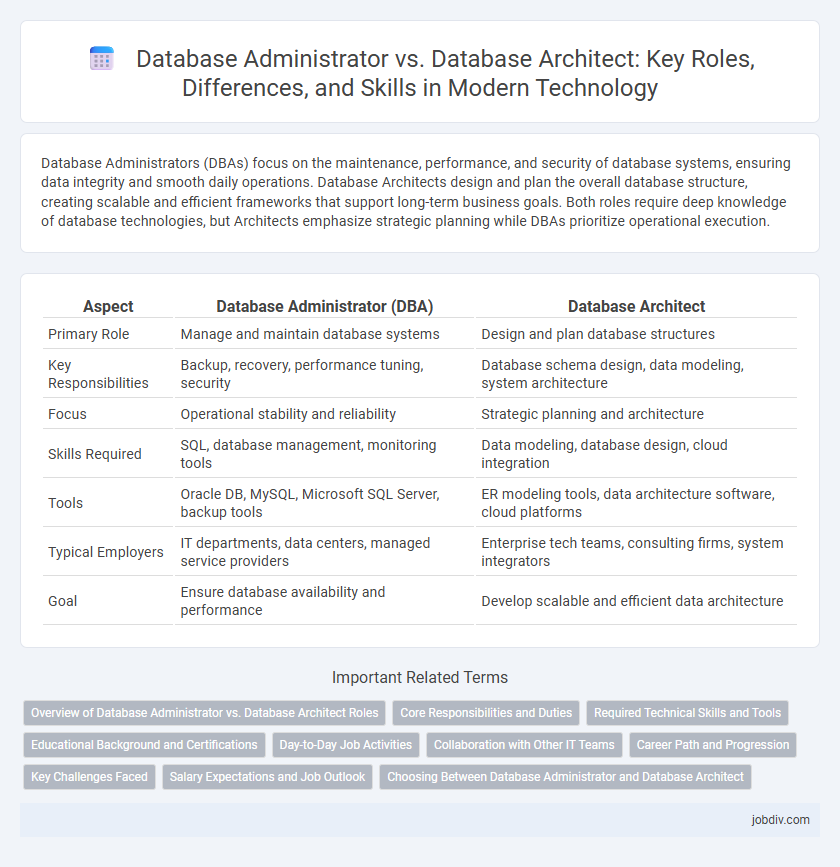Database Administrators (DBAs) focus on the maintenance, performance, and security of database systems, ensuring data integrity and smooth daily operations. Database Architects design and plan the overall database structure, creating scalable and efficient frameworks that support long-term business goals. Both roles require deep knowledge of database technologies, but Architects emphasize strategic planning while DBAs prioritize operational execution.
Table of Comparison
| Aspect | Database Administrator (DBA) | Database Architect |
|---|---|---|
| Primary Role | Manage and maintain database systems | Design and plan database structures |
| Key Responsibilities | Backup, recovery, performance tuning, security | Database schema design, data modeling, system architecture |
| Focus | Operational stability and reliability | Strategic planning and architecture |
| Skills Required | SQL, database management, monitoring tools | Data modeling, database design, cloud integration |
| Tools | Oracle DB, MySQL, Microsoft SQL Server, backup tools | ER modeling tools, data architecture software, cloud platforms |
| Typical Employers | IT departments, data centers, managed service providers | Enterprise tech teams, consulting firms, system integrators |
| Goal | Ensure database availability and performance | Develop scalable and efficient data architecture |
Overview of Database Administrator vs. Database Architect Roles
Database Administrators (DBAs) manage database performance, security, and maintenance, ensuring data integrity and availability for end-users. Database Architects design and plan database structures and frameworks to optimize data storage, retrieval, and scalability aligned with business needs. Both roles are critical, with DBAs focusing on operational management while Database Architects emphasize strategic database design and system architecture.
Core Responsibilities and Duties
Database Administrators (DBAs) manage day-to-day database operations, ensuring data availability, security, and performance tuning through regular maintenance and backups. Database Architects design and model database systems, creating logical and physical schemas to support organizational data strategies and future scalability. Both roles collaborate on data integrity but differ as DBAs focus on implementation and troubleshooting, while architects emphasize strategic planning and system design.
Required Technical Skills and Tools
Database Administrators require expertise in SQL, database management systems like Oracle, MySQL, and performance tuning tools such as SolarWinds Database Performance Analyzer. Database Architects need advanced skills in data modeling, cloud platforms like AWS or Azure, and design tools including ER/Studio or Microsoft Visio. Both roles demand strong proficiency in backup, recovery techniques, and security protocols to ensure data integrity and availability.
Educational Background and Certifications
Database Administrators typically hold degrees in Computer Science or Information Technology and pursue certifications like Oracle Certified Professional (OCP) or Microsoft Certified: Azure Database Administrator Associate to enhance their practical skills. Database Architects often have advanced degrees in Computer Science or Data Engineering with specialized certifications such as AWS Certified Database - Specialty or Google Professional Data Engineer to demonstrate expertise in designing complex database systems. Both roles require strong foundational knowledge of database management systems, but architects focus more on system design while administrators emphasize operational maintenance and performance tuning.
Day-to-Day Job Activities
Database Administrators (DBAs) focus on maintaining database performance, security, and backups, ensuring data integrity and user access management on a daily basis. Database Architects design and implement database structures, optimize data models, and plan scalability solutions to align with business requirements. While DBAs handle operational tasks and troubleshoot issues, Database Architects develop long-term strategies for database systems and oversee infrastructure upgrades.
Collaboration with Other IT Teams
Database Administrators (DBAs) and Database Architects collaborate closely with IT teams to ensure seamless data management and system integration. DBAs focus on maintaining and optimizing database performance, working alongside developers, network engineers, and system administrators to address operational issues and security protocols. Database Architects design scalable and robust database structures, partnering with software architects and data analysts to align database frameworks with business objectives and emerging technologies.
Career Path and Progression
Database Administrators (DBAs) typically begin their careers managing and maintaining database systems, ensuring their performance, security, and availability, with opportunities to advance into senior DBA roles or specialize in areas like performance tuning and disaster recovery. Database Architects focus on designing and implementing complex database solutions, shaping data infrastructure strategies, often progressing to roles such as data architects or chief data officers where they oversee enterprise-wide data architecture and integration. Career progression for both roles demands proficiency in database technologies like SQL, NoSQL, cloud platforms, and strong understanding of data modeling, scalability, and security best practices.
Key Challenges Faced
Database Administrators (DBAs) primarily tackle challenges related to performance tuning, data security, and ensuring system availability, requiring expertise in backup strategies and real-time monitoring. Database Architects confront complexities in designing scalable and flexible database systems that accommodate evolving business needs while integrating diverse data sources. Both roles demand proficiency in managing data integrity and compliance with regulatory requirements amid rapidly changing technology landscapes.
Salary Expectations and Job Outlook
Database administrators typically earn between $70,000 and $110,000 annually, with job growth projected at 8% over the next decade, reflecting steady demand for database maintenance and security expertise. Database architects command higher salaries, often ranging from $100,000 to $150,000, driven by their critical role in designing and optimizing complex data frameworks, with job opportunities expected to grow around 10% due to increasing reliance on scalable database solutions. Both roles are essential in the technology sector, but database architects generally experience broader job outlooks and higher compensation due to the strategic nature of their responsibilities.
Choosing Between Database Administrator and Database Architect
Choosing between a Database Administrator and a Database Architect depends on the organization's focus: Database Administrators specialize in maintaining, tuning, and securing operational databases, ensuring high availability and performance. Database Architects design the overall database structure, plan data models, and create scalable solutions aligning with business requirements and future growth. Organizations prioritizing database reliability and daily management lean towards Database Administrators, while those focusing on strategic data design and long-term architecture benefit from hiring Database Architects.
Database Administrator vs Database Architect Infographic

 jobdiv.com
jobdiv.com